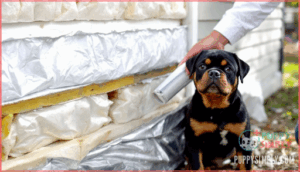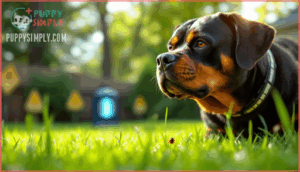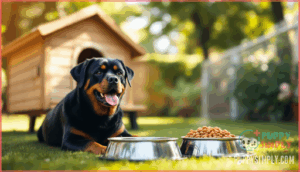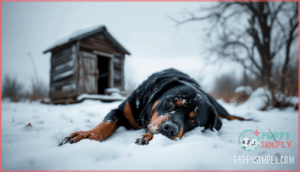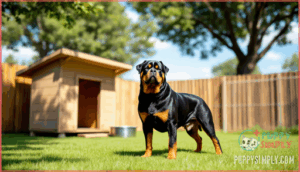This site is supported by our readers. We may earn a commission, at no cost to you, if you purchase through links.
 Your Rottweiler’s ancestors drove cattle through Alpine snowstorms and guarded butchers’ money pouches in medieval markets, but that doesn’t mean your dog belongs outside full-time.
Your Rottweiler’s ancestors drove cattle through Alpine snowstorms and guarded butchers’ money pouches in medieval markets, but that doesn’t mean your dog belongs outside full-time.
While these 80 to 135-pound guardians can handle outdoor work, their double coats struggle below 20°F and their black fur absorbs dangerous heat above 85°F.
More critically, Rottweilers bond intensely with their families—isolation triggers behavioral problems that no amount of weatherproof shelter can fix.
Whether you’re weighing outdoor living for your Rottweiler or trying to understand their limits, the answer depends on climate, shelter quality, and your commitment to daily interaction.
Table Of Contents
- Key Takeaways
- Can Rottweilers Live Outside?
- How Well Do Rottweilers Tolerate Weather?
- What Shelter Do Outdoor Rottweilers Need?
- What Are The Health Risks of Outdoor Living?
- How to Care for an Outdoor Rottweiler
- Frequently Asked Questions (FAQs)
- How much space should an outdoor Rottweiler have?
- What are the best ways to socialize an outdoor Rottweiler?
- How often should I check on my outdoor Rottweiler each day?
- What kind of bedding should I provide for an outdoor Rottweiler?
- How can I keep fleas and ticks off my outdoor Rottweiler?
- Can Rottweilers sleep outside year-round safely?
- Do outdoor Rottweilers need companion animals?
- How often should outdoor Rottweilers come inside?
- What size should a Rottweiler outdoor shelter be?
- Are Rottweilers more aggressive when kept outside?
- Conclusion
Key Takeaways
- Rottweilers can technically live outside but shouldn’t be kept outdoors full-time because they’re bred for human partnership and suffer from isolation-driven behavioral problems despite their working heritage.
- Their double coat handles moderate temperatures (39°F to 70°F) reasonably well, but they struggle dangerously below 20°F due to hypothermia risk and above 85°F because their black fur absorbs heat rapidly, causing heatstroke within 15 minutes.
- Outdoor living requires weatherproof insulation, pest protection, fresh water access, and at least 1-2 hours daily of human interaction to prevent the anxiety and destructive behaviors that affect 43% of isolated dogs.
- Health risks multiply outdoors, including 35% higher injury rates, 44% parasite exposure in contaminated areas, and significantly increased chances of temperature-related illness compared to indoor dogs.
Can Rottweilers Live Outside?
Rottweilers can live outside, but it’s not a simple yes or no answer. Their double coat offers some weather protection, yet they weren’t bred to be exclusively outdoor dogs.
Let’s look at what makes this breed suitable—or unsuitable—for outdoor living.
Breed Traits and Outdoor Suitability
Rottweilers have physical traits that make outdoor living possible, but their temperament factors matter just as much. Their double coat adaptations help manage moderate temperatures, though they’re less cold-tolerant than Arctic breeds. One factor is that larger dogs tolerate cold better.
Consider these breed characteristics:
- Adult Rottweilers weigh 80–135 pounds, aiding heat retention
- Double coat provides seasonal insulation but limits extreme cold tolerance
- Strong bonding instincts mean they struggle with prolonged isolation
- Exercise needs require minimum 2 hours daily physical activity
- Black coat increases heat absorption, raising heatstroke risk above 85°F
Your Rottweiler’s size considerations and socialization impact mean outdoor living demands constant supervision, proper shelter, and daily interaction to prevent behavioral issues.
Historical Roles as Outdoor Dogs
This breed’s outdoor history runs deeper than you might think. Roman drover dogs traveled with armies around A.D. 74, herding cattle through the Alps and protecting supply trains in all weather. Those mastiff-type ancestors worked outdoors year-round, laying the groundwork for what we now recognize as the working group heritage.
By medieval times, the "Rottweiler Metzgerhund" drove cattle to market, with butchers trusting them to guard money pouches on their collars. Cart pulling duties came next—these dogs hauled meat wagons through rain and snow across southern Germany.
When industrialization nearly wiped out the breed by 1882, Rottweilers found new purpose in police and military service during both World Wars, serving as messenger and guard dogs under harsh field conditions. The breed’s original role involved herding and protecting cattle for Roman legions.
Today’s Rottweiler history and origin still echoes in their watchdog instincts, though modern adaptations favor indoor companionship over the grueling outdoor labor their ancestors endured.
Key Considerations for Outdoor Living
While that working heritage shaped the breed, outdoor living today requires careful planning. You’ll need climate adaptation strategies since Rottweilers tolerate 39°F to 70°F comfortably but struggle beyond those limits. Shelter requirements include insulation, weatherproofing, and shade to prevent heat stroke from their dark coats.
Social interaction can’t be compromised—isolation triggers behavioral problems. Outdoor safety means secure six-foot fencing, daily supervision, and monitoring for thermal stress.
Don’t overlook dietary needs and Rottweiler health concerns like parasites from outdoor exposure, making regular vet checks non-negotiable for cold weather dog care.
How Well Do Rottweilers Tolerate Weather?
Your Rottweiler’s tolerance for outdoor weather depends on three critical factors: cold limits, heat sensitivity, and overall climate conditions. Understanding these elements helps you determine whether your dog can safely spend time outside in your area.
Let’s look at each factor and what they mean for your Rottweiler’s well-being.
Cold Tolerance and Temperature Limits
How much cold can your Rottweiler handle before it becomes dangerous? These dogs are most comfortable between 39°F and 70°F, thanks to their double coat and muscular build. Below 40°F, you’ll need to watch them closely and limit outdoor time.
Their dense undercoat thickens in winter through cold acclimatization, offering decent protection. However, prolonged exposure below 20°F increases hypothermia risks and frostbite prevention becomes critical.
Active, supervised sessions may work briefly near 0°F, but shelter requirements become non-negotiable as temperatures drop.
Heat Sensitivity and Overheating Risks
Heat challenges your Rottweiler differently than cold. Their black coat absorbs sunlight fast, pushing heatstroke symptoms to appear within 15 minutes above 95°F. Large, muscular dogs face three times the risk of overheating compared to smaller breeds, and their body mass limits heat dissipation.
Humidity above 70% makes things worse by blocking their natural cooling through panting.
- Watch for danger above 80°F: Heat stress begins here, with sharp heatstroke risk above 90°F
- Time walks wisely: Morning exercise prevents 30-40% faster temperature spikes during midday heat
- Skip hot pavement: Asphalt reaches 125°F at just 77°F air temperature, burning paws and raising body heat
- Provide active cooling: Water misting drops body temperature 3°F within 10 minutes during overheating episodes
- Monitor weight closely: Obesity increases heatstroke odds by 50%, as fat blocks heat release
Climate Factors Affecting Outdoor Life
Beyond temperature alone, multiple climate factors shape your Rottweiler’s cold weather tolerance outdoors. Wind chill drops apparent temperature by 10–25°F, while humidity above 85% combined with cold temperatures causes severe body cooling even without freezing conditions.
Wet fur loses 60% of its insulating ability, making rain or snow the biggest threat.
Seasonal variation matters too—your dog’s coat adaptation takes 6–8 weeks when weather shifts, and spring shedding reduces insulation by 40%.
Urban areas stay 2–5°F warmer than rural zones, offering habitat mitigation against extreme cold.
What Shelter Do Outdoor Rottweilers Need?
If your Rottweiler will spend significant time outdoors, the shelter you provide isn’t just a nice-to-have—it’s essential for their health and safety. A proper outdoor setup protects them from weather extremes, keeps pests at bay, and ensures they’ve what they need to stay comfortable.
Let’s look at the key elements every outdoor shelter should include.
Insulation and Weatherproofing
You’ll need solid insulation and weatherproofing to keep your Rottweiler safe outdoors. Rigid foam boards with R-values around R-4.5 per inch work well, paired with reflective foil that bounces back up to 97% of radiant heat.
Proper weatherproofing cuts drafts and moisture by over half, while sealed joints and rain overhangs protect against wind and precipitation.
Cover insulation materials with protective barriers to prevent chewing, and maintain these systems seasonally for lasting thermal performance.
Protection From Pests and Hazards
Your outdoor Rottweiler faces serious threats from ticks, fleas, mosquitoes carrying heartworms, and wildlife encounters that spread parasites. Tick prevention is critical year-round, especially with ehrlichiosis and Lyme disease expanding northward into Minnesota and New York.
Mosquito risks have jumped 10–15% in suburban areas, making heartworm protection essential. Chemical exposure from lawn treatments causes frequent poisoning emergencies, so restrict yard access 24–48 hours after applications.
Annual parasite screening detects infections early, protecting both outdoor dog safety and your family’s health.
Access to Fresh Water and Food
Your Rottweiler needs constant access to clean, fresh water—about 70 to 120 ounces daily for adults, more in heat or after exercise. Hydration monitoring prevents dehydration, spotted through dry gums or lethargy.
Food portioning matters too: most adults need 2⅓ to 4½ cups split across two meals. Water bowl hygiene is non-negotiable—daily cleaning stops bacteria.
Feeding schedules keep digestion steady, and dietary adjustments help seniors or active dogs thrive.
What Are The Health Risks of Outdoor Living?
Keeping your Rottweiler outside full-time introduces several health challenges you need to understand. From temperature extremes to mental well-being, outdoor living creates risks that don’t exist indoors.
Let’s look at the three main health concerns you’ll face with an outdoor Rottweiler.
Exposure to Extreme Temperatures
Extreme temperatures test your Rottweiler’s limits in ways you can’t ignore. Cold temperatures below 20°F put them at risk for hypothermia and frostbite, especially on their ears and paws. On the flip side, heat above 90°F can trigger heatstroke within 15 minutes in direct sun. Wind chill accelerates heat loss, while humidity impairs cooling through panting.
Their double coat adapts seasonally, but these natural coat adaptations only go so far when freezing temperatures or scorching days persist.
Potential for Boredom and Loneliness
Beyond physical risks, isolation takes a real toll on your Rottweiler’s mental health. Dogs left alone longer than six hours show destructive behaviors like chewing and digging in 43% of cases without mental stimulation. Single-housed dogs engage in 34% more repetitive behaviors than those with companions.
That’s why human interaction and physical stimulation matter—dogs denied regular engagement bark 22% more and show anxiety symptoms rising by 63% when environmental enrichment is lacking.
Increased Risk of Injury or Illness
Physical dangers multiply when your Rottweiler lives outdoors full-time. Over 35% of dogs trained outside sustain orthopedic injuries, especially to the shoulder and forelimbs, with hard surfaces increasing the risk.
Zoonotic diseases are common—26% of owned dogs harbor intestinal parasites, and environmental exposure raises that to 44% in contaminated areas.
Heat-related illnesses, life-threatening conditions like bloat and osteosarcoma, and environmental hazards from toxins or wildlife all threaten outdoor Rottweilers more than indoor dogs.
How to Care for an Outdoor Rottweiler
If your Rottweiler lives outside, you can’t just set up shelter and walk away. These dogs need consistent care to stay healthy and happy in an outdoor environment.
Here’s what you should focus on to give your outdoor Rottweiler the best life possible.
Exercise and Enrichment Needs
Regularly, your outdoor Rottweiler needs 1.5 to 2 hours of daily exercise to stay healthy and prevent boredom, which often leads to destructive chewing or excessive barking. Mental stimulation through puzzle toys and scent games is just as important as physical activity.
Essential exercise and enrichment include:
- Vigorous activities like swimming, hiking, or fetch sessions spanning the full daily exercise requirement
- Brain games such as puzzle feeders and obedience drills to challenge their working-dog intelligence
- Interactive play including tug-of-war and agility courses to build strength without stressing joints
- Structured routines divided into multiple sessions, especially during hot weather, to avoid overexertion
Insufficient exercise increases obesity risk and leads to frustration-based behavioral problems in Rottweilers.
Training and Socialization Outdoors
Early socialization outdoors reduces fear-based aggression by up to 60% when you start between 8 and 16 weeks. Leash training with positive rewards beginning at 8 weeks improves impulse control, while meeting other dogs in neutral outdoor spaces lowers territorial behaviors by 35%.
Confidence building through varied sounds, smells, and supervised exploration strengthens your Rottweiler’s adaptability.
Ongoing integration throughout adulthood prevents behavioral regression and maintains social competence.
Regular Health and Wellness Checks
Outdoor Rottweilers face unique health challenges, so scheduled veterinary care protects against preventable conditions. Your dog needs:
- Puppy vaccinations every 3–4 weeks from 6 to 16 weeks, covering distemper, parvovirus, and rabies
- Annual screenings including hip, cardiac, and tick-borne disease testing for outdoor exposure risks
- Senior checkups every 6 months after age 7 to catch arthritis and organ changes early
- Dental health exams preventing periodontal disease affecting 80% of adult dogs
- Parasite prevention with quarterly deworming and year-round heartworm protection in warm climates
Regular veterinary care catches issues before they become emergencies.
Frequently Asked Questions (FAQs)
How much space should an outdoor Rottweiler have?
Space is the soul of the canine kingdom—your Rottweiler needs at least 40-50 square feet to move comfortably outdoors.
Kennel dimensions should measure approximately 6 by 10 feet, though larger spaces better support their exercise needs and natural behaviors.
What are the best ways to socialize an outdoor Rottweiler?
Introduce your Rottweiler to other dogs gradually in neutral outdoor spaces using parallel leashed walks. Early introductions build confidence, while controlled exposure prevents fear.
Consistent human interaction, structured training effectiveness, and enrichment strategies like puzzle toys support healthy dog socialization throughout their life.
How often should I check on my outdoor Rottweiler each day?
Some folks think checking once a day is enough, but weather conditions and distress signs demand more attention.
During extreme heat or cold, check every two to three hours to monitor health and prevent emergencies.
What kind of bedding should I provide for an outdoor Rottweiler?
Choose elevated beds with waterproof, chew-resistant materials like ballistic nylon or ripstop fabric. These provide pest control by keeping your dog off the ground, offer orthopedic support for joints, and resist moisture.
Add insulated bedding inside the dog house during cold months for extra warmth.
How can I keep fleas and ticks off my outdoor Rottweiler?
You can protect your outdoor Rottweiler from fleas and ticks using topical preventatives that last 4-12 weeks, oral medications effective for about one month, and professional yard treatments that reduce pests by 95% for four to six weeks.
Can Rottweilers sleep outside year-round safely?
A Michigan family learned this lesson when their Rottweiler developed frostbite after sleeping outdoors in February without adequate shelter.
Year-round outdoor sleeping isn’t safe for Rottweilers because temperatures below 20°F increase hypothermia risk, while heat above 90°F causes dangerous overheating.
Proper shelter quality, health monitoring, and owner responsibility determine whether your Rottweiler can handle outdoor sleeping safely during mild seasons.
Do outdoor Rottweilers need companion animals?
Yes, companion animals help considerably. Rottweilers are social dogs with strong pack dynamics, and social isolation can trigger behavioral impacts like anxiety, depression, and destructive habits.
Another dog provides shared resources, activity levels, and companionship that reduce loneliness and stress.
How often should outdoor Rottweilers come inside?
Outdoor Rottweilers should come inside daily for social interaction and indoor bonding, ideally spending at least 1-2 hours with you.
This protects them from environmental hazards, allows health monitoring, and prevents behavioral issues that develop when temperature thresholds or isolation become problematic for your Rottweiler’s well-being.
What size should a Rottweiler outdoor shelter be?
Your outdoor dog shelter requirements should provide at least 60 square feet of floor space, with dimensions around 6 by 10 feet and a 6-foot height. Climate impact matters—cold regions need 20-30% more space for insulation and movement.
Internal features like waterproof shelter bedding and separate feeding areas require additional room, while proper ventilation needs and space allocation prevent overheating in Rottweiler breed characteristics suited for outdoor dog sleeping conditions.
Are Rottweilers more aggressive when kept outside?
Without proper care, outdoor Rottweilers can turn into ticking time bombs. Environmental stressors, social deprivation, and territorial instincts combine with genetic predispositions to trigger fear-based aggression, especially when dog behavior isn’t managed through consistent Rottweiler training and socialization.
Without proper care and socialization, outdoor Rottweilers face heightened aggression risks from isolation, environmental stress, and territorial instincts
Conclusion
Sure, your Rottweiler could technically survive outside with a deluxe doghouse and gourmet kibble—just like you could live in your garage if it had a heater and Wi-Fi. But surviving isn’t thriving. Whether Rottweilers can live outside isn’t the right question; it’s whether they should.
These dogs were bred to work alongside humans, not watch life through chain-link. Temperature extremes, isolation-driven anxiety, and preventable health risks make outdoor-only living a hard sell when your dog’s DNA is hardwired for partnership, not solitary confinement.
- https://www.rottweilersonline.com/threads/can-rottweilers-be-kept-as-outdoor-dogs.18393/
- https://www.dogster.com/lifestyle/can-rottweilers-handle-cold-weather
- https://www.poochandmutt.co.uk/blogs/by-breed/rottweiler
- https://www.amrottclub.org/about-the-rottweiler/owning-a-rottweiler/
- https://www.embracepetinsurance.com/dog-breeds/rottweiler


